Lancia Musa 2010 Owner handbook (in English)
Manufacturer: LANCIA, Model Year: 2010, Model line: Musa, Model: Lancia Musa 2010Pages: 218, PDF Size: 3.71 MB
Page 101 of 218
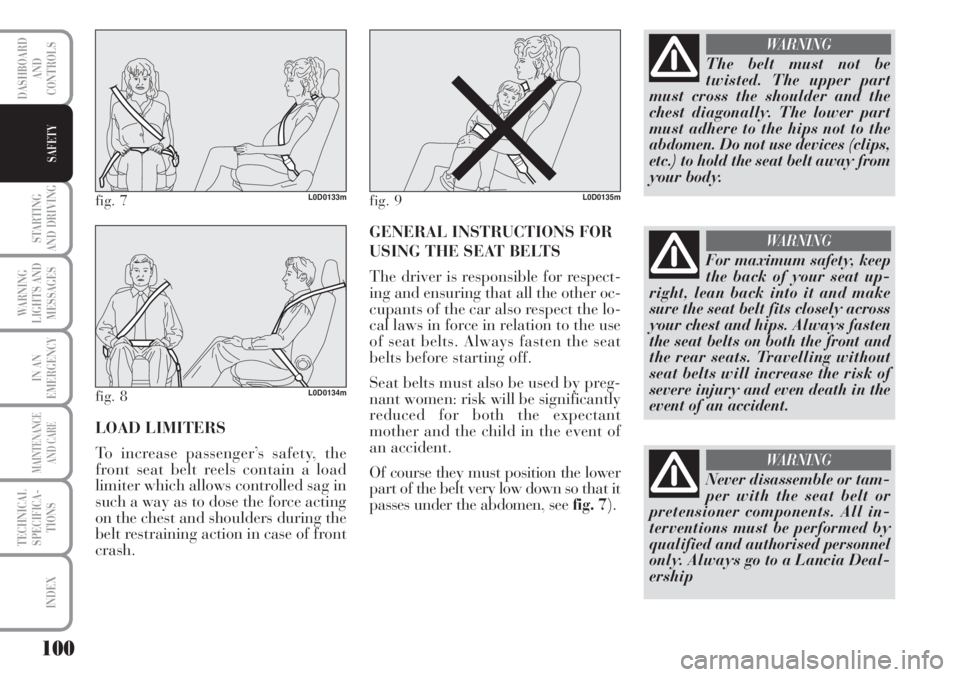
100
STARTING
AND DRIVING
WARNING
LIGHTS AND
MESSAGES
IN AN
EMERGENCY
MAINTENANCE
AND CARE
TECHNICAL
SPECIFICA-
TIONS
INDEX
DASHBOARD
AND
CONTROLS
SAFETY
LOAD LIMITERS
To increase passenger’s safety, the
front seat belt reels contain a load
limiter which allows controlled sag in
such a way as to dose the force acting
on the chest and shoulders during the
belt restraining action in case of front
crash.GENERAL INSTRUCTIONS FOR
USING THE SEAT BELTS
The driver is responsible for respect-
ing and ensuring that all the other oc-
cupants of the car also respect the lo-
cal laws in force in relation to the use
of seat belts. Always fasten the seat
belts before starting off.
Seat belts must also be used by preg-
nant women: risk will be significantly
reduced for both the expectant
mother and the child in the event of
an accident.
Of course they must position the lower
part of the belt very low down so that it
passes under the abdomen, see fig. 7).
fig. 7L0D0133m
fig. 8L0D0134m
fig. 9L0D0135m
The belt must not be
twisted. The upper part
must cross the shoulder and the
chest diagonally. The lower part
must adhere to the hips not to the
abdomen. Do not use devices (clips,
etc.) to hold the seat belt away from
your body.
WARNING
Never disassemble or tam-
per with the seat belt or
pretensioner components. All in-
terventions must be performed by
qualified and authorised personnel
only. Always go to a Lancia Deal-
ership
WARNING
For maximum safety, keep
the back of your seat up-
right, lean back into it and make
sure the seat belt fits closely across
your chest and hips. Always fasten
the seat belts on both the front and
the rear seats. Travelling without
seat belts will increase the risk of
severe injury and even death in the
event of an accident.
WARNING
Page 102 of 218
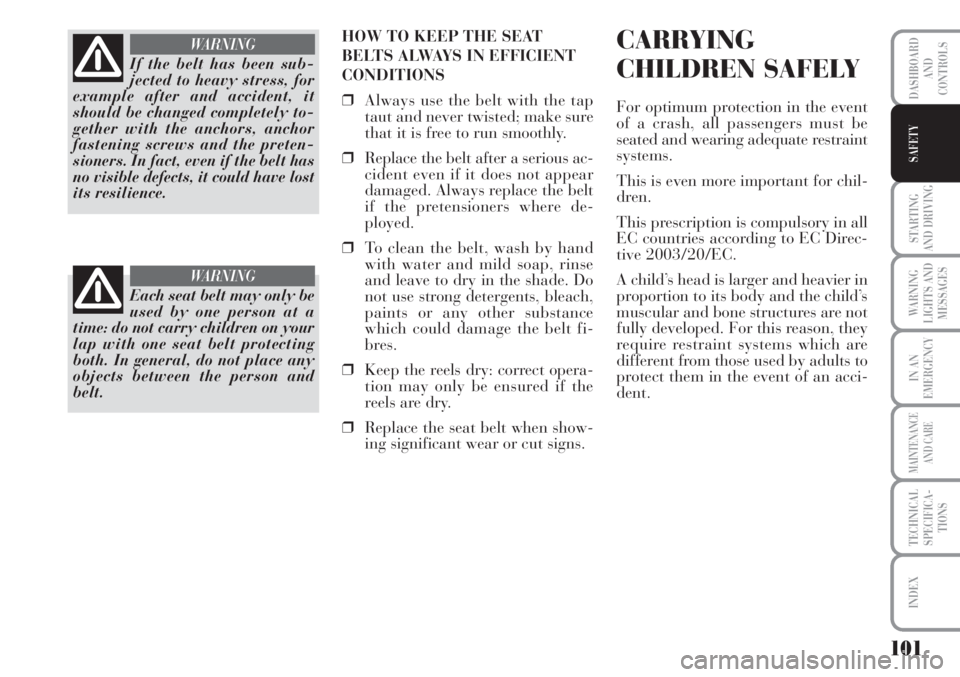
101
STARTING
AND DRIVING
WARNING
LIGHTS AND
MESSAGES
IN AN
EMERGENCY
MAINTENANCE
AND CARE
TECHNICAL
SPECIFICA-
TIONS
INDEX
DASHBOARD
AND
CONTROLS
SAFETY
HOW TO KEEP THE SEAT
BELTS ALWAYS IN EFFICIENT
CONDITIONS
❒Always use the belt with the tap
taut and never twisted; make sure
that it is free to run smoothly.
❒Replace the belt after a serious ac-
cident even if it does not appear
damaged. Always replace the belt
if the pretensioners where de-
ployed.
❒To clean the belt, wash by hand
with water and mild soap, rinse
and leave to dry in the shade. Do
not use strong detergents, bleach,
paints or any other substance
which could damage the belt fi-
bres.
❒Keep the reels dry: correct opera-
tion may only be ensured if the
reels are dry.
❒Replace the seat belt when show-
ing significant wear or cut signs.CARRYING
CHILDREN SAFELY
For optimum protection in the event
of a crash, all passengers must be
seated and wearing adequate restraint
systems.
This is even more important for chil-
dren.
This prescription is compulsory in all
EC countries according to EC Direc-
tive 2003/20/EC.
A child’s head is larger and heavier in
proportion to its body and the child’s
muscular and bone structures are not
fully developed. For this reason, they
require restraint systems which are
different from those used by adults to
protect them in the event of an acci-
dent.
If the belt has been sub-
jected to heavy stress, for
example after and accident, it
should be changed completely to-
gether with the anchors, anchor
fastening screws and the preten-
sioners. In fact, even if the belt has
no visible defects, it could have lost
its resilience.
WARNING
Each seat belt may only be
used by one person at a
time: do not carry children on your
lap with one seat belt protecting
both. In general, do not place any
objects between the person and
belt.
WARNING
Page 103 of 218
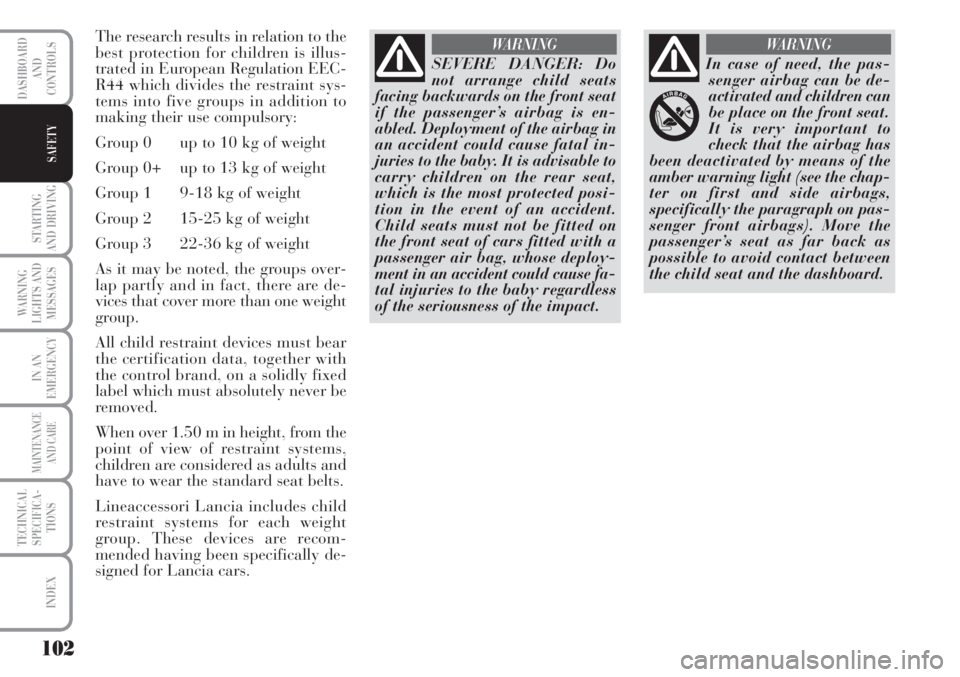
102
STARTING
AND DRIVING
WARNING
LIGHTS AND
MESSAGES
IN AN
EMERGENCY
MAINTENANCE
AND CARE
TECHNICAL
SPECIFICA-
TIONS
INDEX
DASHBOARD
AND
CONTROLS
SAFETY
The research results in relation to the
best protection for children is illus-
trated in European Regulation EEC-
R44 which divides the restraint sys-
tems into five groups in addition to
making their use compulsory:
Group 0 up to 10 kg of weight
Group 0+ up to 13 kg of weight
Group 1 9-18 kg of weight
Group 2 15-25 kg of weight
Group 3 22-36 kg of weight
As it may be noted, the groups over-
lap partly and in fact, there are de-
vices that cover more than one weight
group.
All child restraint devices must bear
the certification data, together with
the control brand, on a solidly fixed
label which must absolutely never be
removed.
When over 1.50 m in height, from the
point of view of restraint systems,
children are considered as adults and
have to wear the standard seat belts.
Lineaccessori Lancia includes child
restraint systems for each weight
group. These devices are recom-
mended having been specifically de-
signed for Lancia cars.
SEVERE DANGER: Do
not arrange child seats
facing backwards on the front seat
if the passenger’s airbag is en-
abled. Deployment of the airbag in
an accident could cause fatal in-
juries to the baby. It is advisable to
carry children on the rear seat,
which is the most protected posi-
tion in the event of an accident.
Child seats must not be fitted on
the front seat of cars fitted with a
passenger air bag, whose deploy-
ment in an accident could cause fa-
tal injuries to the baby regardless
of the seriousness of the impact.
WARNING
In case of need, the pas-
senger airbag can be de-
activated and children can
be place on the front seat.
It is very important to
check that the airbag has
been deactivated by means of the
amber warning light (see the chap-
ter on first and side airbags,
specifically the paragraph on pas-
senger front airbags). Move the
passenger’s seat as far back as
possible to avoid contact between
the child seat and the dashboard.
WARNING
Page 104 of 218
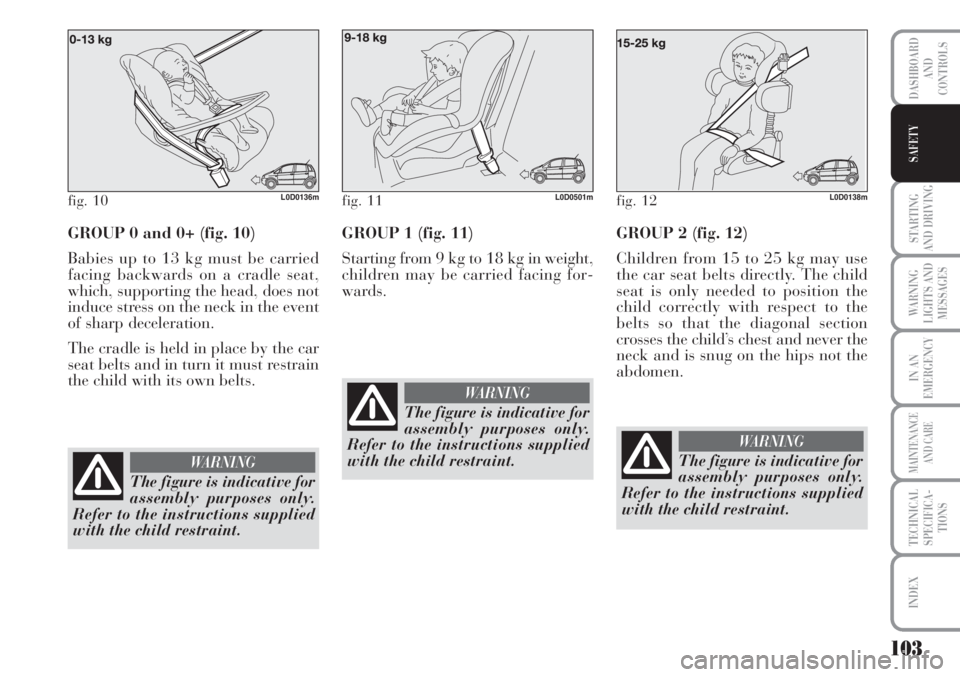
103
STARTING
AND DRIVING
WARNING
LIGHTS AND
MESSAGES
IN AN
EMERGENCY
MAINTENANCE
AND CARE
TECHNICAL
SPECIFICA-
TIONS
INDEX
DASHBOARD
AND
CONTROLS
SAFETY
GROUP 0 and 0+ (fig. 10)
Babies up to 13 kg must be carried
facing backwards on a cradle seat,
which, supporting the head, does not
induce stress on the neck in the event
of sharp deceleration.
The cradle is held in place by the car
seat belts and in turn it must restrain
the child with its own belts.GROUP 1 (fig. 11)
Starting from 9 kg to 18 kg in weight,
children may be carried facing for-
wards.
fig. 11L0D0501mfig. 12L0D0138mfig. 10L0D0136m
The figure is indicative for
assembly purposes only.
Refer to the instructions supplied
with the child restraint.
WARNING
The figure is indicative for
assembly purposes only.
Refer to the instructions supplied
with the child restraint.
WARNING
GROUP 2 (fig. 12)
Children from 15 to 25 kg may use
the car seat belts directly. The child
seat is only needed to position the
child correctly with respect to the
belts so that the diagonal section
crosses the child’s chest and never the
neck and is snug on the hips not the
abdomen.
The figure is indicative for
assembly purposes only.
Refer to the instructions supplied
with the child restraint.
WARNING
Page 105 of 218
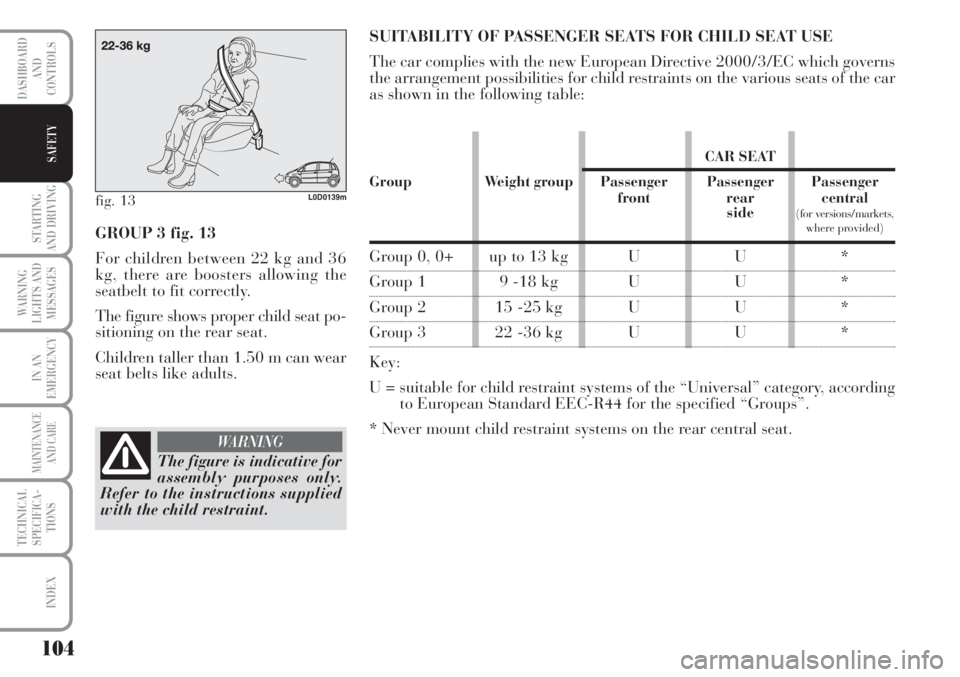
104
STARTING
AND DRIVING
WARNING
LIGHTS AND
MESSAGES
IN AN
EMERGENCY
MAINTENANCE
AND CARE
TECHNICAL
SPECIFICA-
TIONS
INDEX
DASHBOARD
AND
CONTROLS
SAFETY
fig. 13L0D0139m
GROUP 3 fig. 13
For children between 22 kg and 36
kg, there are boosters allowing the
seatbelt to fit correctly.
The figure shows proper child seat po-
sitioning on the rear seat.
Children taller than 1.50 m can wear
seat belts like adults.
The figure is indicative for
assembly purposes only.
Refer to the instructions supplied
with the child restraint.
WARNING
SUITABILITY OF PASSENGER SEATS FOR CHILD SEAT USE
The car complies with the new European Directive 2000/3/EC which governs
the arrangement possibilities for child restraints on the various seats of the car
as shown in the following table:
CAR SEAT
Group Weight group Passenger Passenger Passenger
front rear central
side
(for versions/markets,where provided)
Group 0, 0+ up to 13 kg U U *
Group 1 9 -18 kg U U *
Group 2 15 -25 kg U U *
Group 3 22 -36 kg U U *
Key:
U = suitable for child restraint systems of the “Universal” category, according
to European Standard EEC-R44 for the specified “Groups”.
* Never mount child restraint systems on the rear central seat.
Page 106 of 218
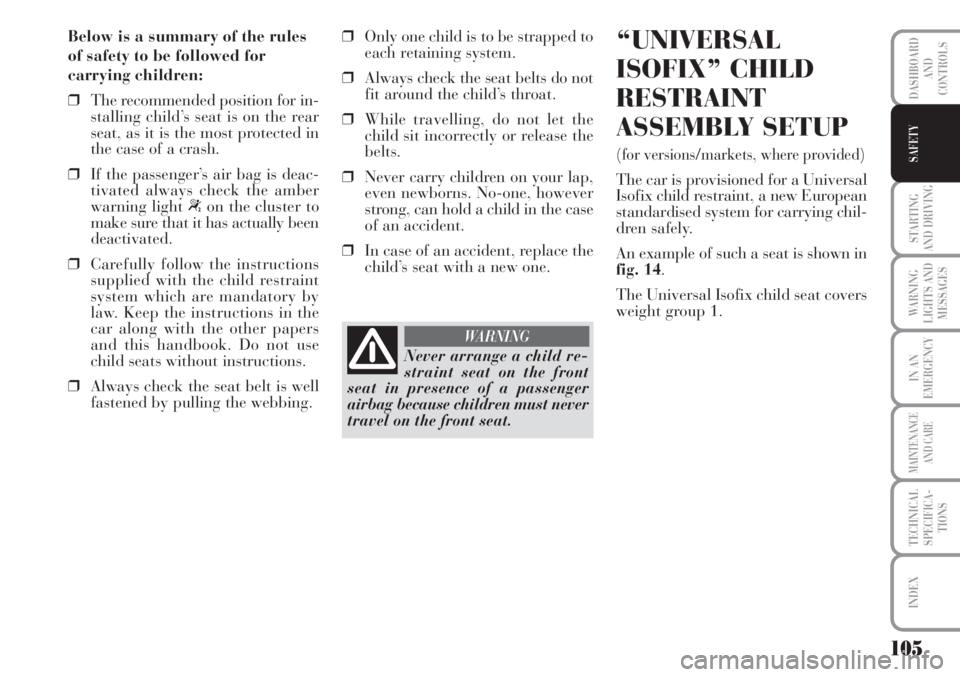
105
STARTING
AND DRIVING
WARNING
LIGHTS AND
MESSAGES
IN AN
EMERGENCY
MAINTENANCE
AND CARE
TECHNICAL
SPECIFICA-
TIONS
INDEX
DASHBOARD
AND
CONTROLS
SAFETY
Below is a summary of the rules
of safety to be followed for
carrying children:
❒The recommended position for in-
stalling child’s seat is on the rear
seat, as it is the most protected in
the case of a crash.
❒If the passenger’s air bag is deac-
tivated always check the amber
warning light “on the cluster to
make sure that it has actually been
deactivated.
❒Carefully follow the instructions
supplied with the child restraint
system which are mandatory by
law. Keep the instructions in the
car along with the other papers
and this handbook. Do not use
child seats without instructions.
❒Always check the seat belt is well
fastened by pulling the webbing.❒Only one child is to be strapped to
each retaining system.
❒Always check the seat belts do not
fit around the child’s throat.
❒While travelling, do not let the
child sit incorrectly or release the
belts.
❒Never carry children on your lap,
even newborns. No-one, however
strong, can hold a child in the case
of an accident.
❒In case of an accident, replace the
child’s seat with a new one. “UNIVERSAL
ISOFIX” CHILD
RESTRAINT
ASSEMBLY SETUP
(for versions/markets, where provided)
The car is provisioned for a Universal
Isofix child restraint, a new European
standardised system for carrying chil-
dren safely.
An example of such a seat is shown in
fig. 14.
The Universal Isofix child seat covers
weight group 1.
Never arrange a child re-
straint seat on the front
seat in presence of a passenger
airbag because children must never
travel on the front seat.
WARNING
Page 107 of 218
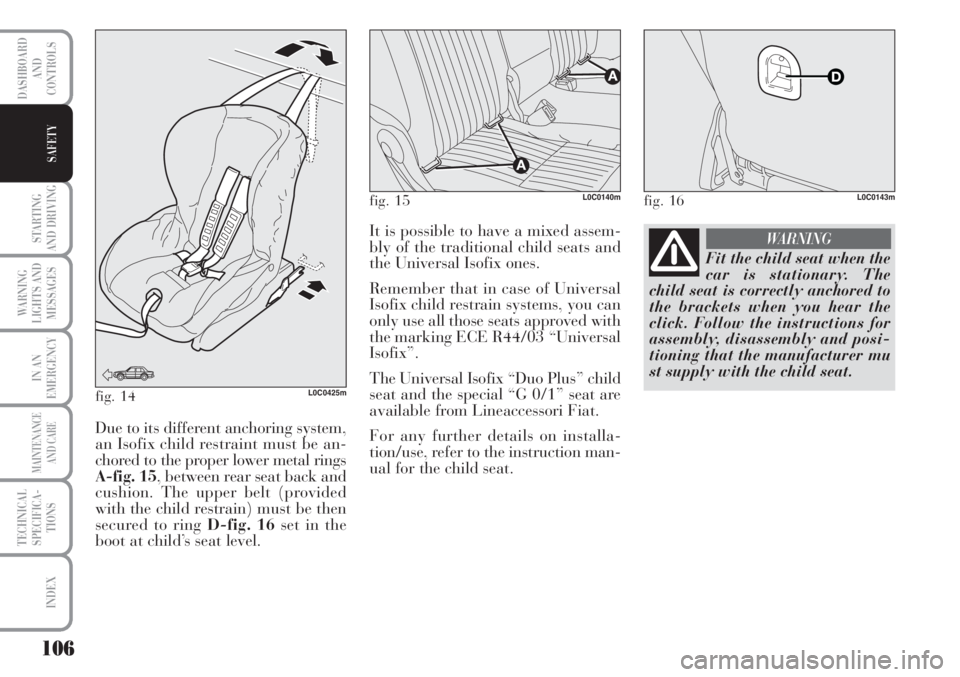
106
STARTING
AND DRIVING
WARNING
LIGHTS AND
MESSAGES
IN AN
EMERGENCY
MAINTENANCE
AND CARE
TECHNICAL
SPECIFICA-
TIONS
INDEX
DASHBOARD
AND
CONTROLS
SAFETY
fig. 14L0C0425m
Due to its different anchoring system,
an Isofix child restraint must be an-
chored to the proper lower metal rings
A-fig. 15, between rear seat back and
cushion. The upper belt (provided
with the child restrain) must be then
secured to ring D-fig. 16set in the
boot at child’s seat level.
fig. 15L0C0140m
It is possible to have a mixed assem-
bly of the traditional child seats and
the Universal Isofix ones.
Remember that in case of Universal
Isofix child restrain systems, you can
only use all those seats approved with
the marking ECE R44/03 “Universal
Isofix”.
The Universal Isofix “Duo Plus” child
seat and the special “G 0/1” seat are
available from Lineaccessori Fiat.
For any further details on installa-
tion/use, refer to the instruction man-
ual for the child seat.
fig. 16L0C0143m
Fit the child seat when the
car is stationary. The
child seat is correctly anchored to
the brackets when you hear the
click. Follow the instructions for
assembly, disassembly and posi-
tioning that the manufacturer mu
st supply with the child seat.
WARNING
Page 108 of 218
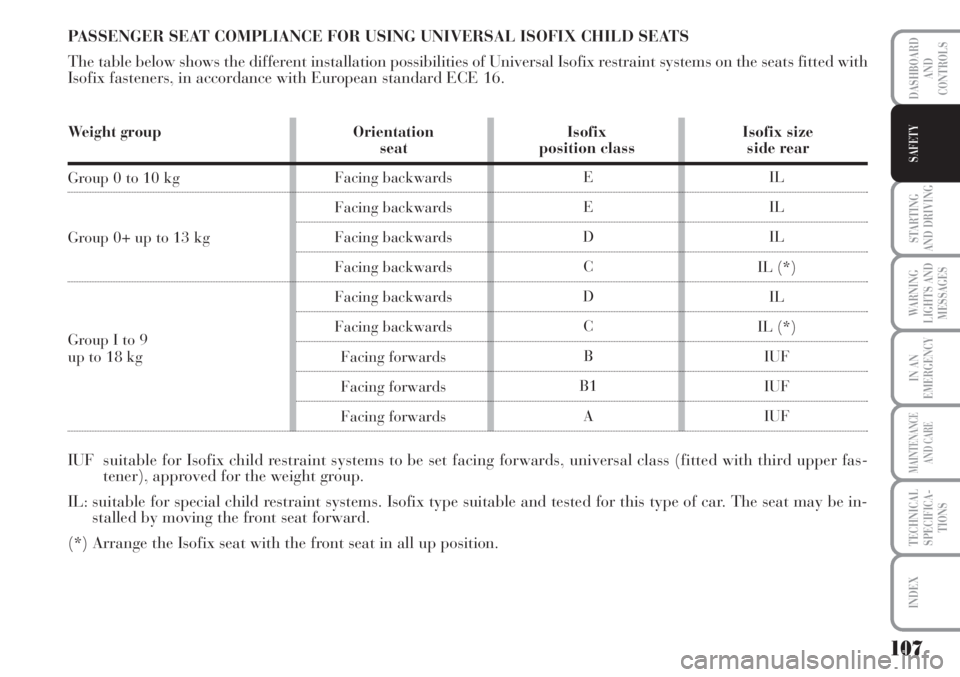
107
STARTING
AND DRIVING
WARNING
LIGHTS AND
MESSAGES
IN AN
EMERGENCY
MAINTENANCE
AND CARE
TECHNICAL
SPECIFICA-
TIONS
INDEX
DASHBOARD
AND
CONTROLS
SAFETY
PASSENGER SEAT COMPLIANCE FOR USING UNIVERSAL ISOFIX CHILD SEATS
The table below shows the different installation possibilities of Universal Isofix restraint systems on the seats fitted with
Isofix fasteners, in accordance with European standard ECE 16.
Weight group Orientation Isofix Isofix sizeseat position class side rear
Group 0 to 10 kg
Group 0+ up to 13 kg
Group I to 9
up to 18 kg
Facing backwards
Facing backwards
Facing backwards
Facing backwards
Facing backwards
Facing backwards
Facing forwards
Facing forwards
Facing forwardsE
E
D
C
D
C
B
B1
AIL
IL
IL
IL (*)
IL
IL (*)
IUF
IUF
IUF
IUF suitable for Isofix child restraint systems to be set facing forwards, universal class (fitted with third upper fas-
tener), approved for the weight group.
IL: suitable for special child restraint systems. Isofix type suitable and tested for this type of car. The seat may be in-
stalled by moving the front seat forward.
(*) Arrange the Isofix seat with the front seat in all up position.
Page 109 of 218
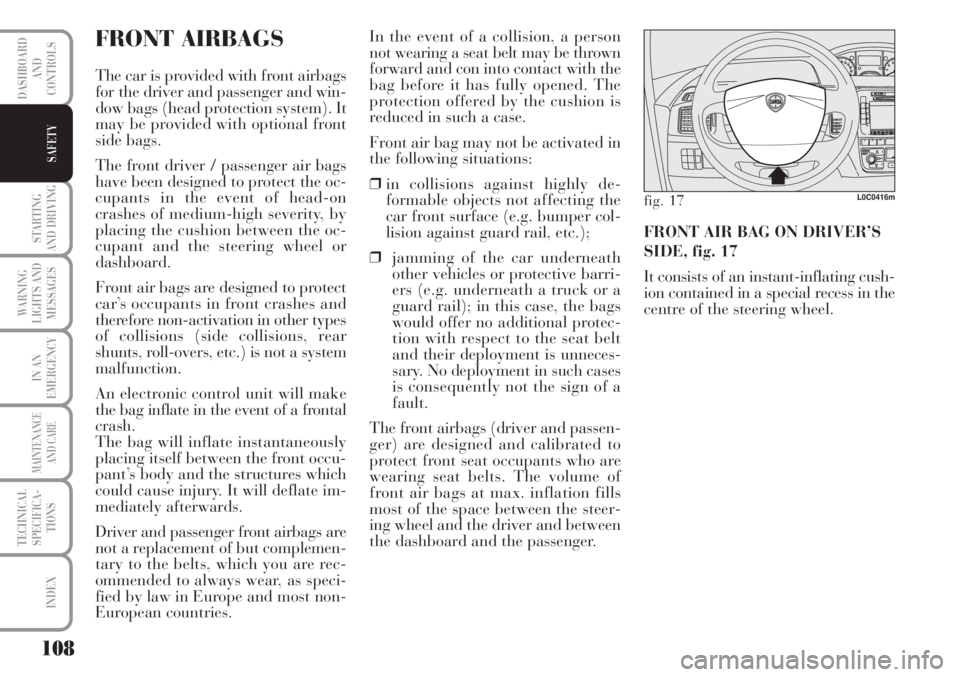
108
STARTING
AND DRIVING
WARNING
LIGHTS AND
MESSAGES
IN AN
EMERGENCY
MAINTENANCE
AND CARE
TECHNICAL
SPECIFICA-
TIONS
INDEX
DASHBOARD
AND
CONTROLS
SAFETY
FRONT AIRBAGS
The car is provided with front airbags
for the driver and passenger and win-
dow bags (head protection system). It
may be provided with optional front
side bags.
The front driver / passenger air bags
have been designed to protect the oc-
cupants in the event of head-on
crashes of medium-high severity, by
placing the cushion between the oc-
cupant and the steering wheel or
dashboard.
Front air bags are designed to protect
car’s occupants in front crashes and
therefore non-activation in other types
of collisions (side collisions, rear
shunts, roll-overs, etc.) is not a system
malfunction.
An electronic control unit will make
the bag inflate in the event of a frontal
crash.
The bag will inflate instantaneously
placing itself between the front occu-
pant’s body and the structures which
could cause injury. It will deflate im-
mediately afterwards.
Driver and passenger front airbags are
not a replacement of but complemen-
tary to the belts, which you are rec-
ommended to always wear, as speci-
fied by law in Europe and most non-
European countries.In the event of a collision, a person
not wearing a seat belt may be thrown
forward and con into contact with the
bag before it has fully opened. The
protection offered by the cushion is
reduced in such a case.
Front air bag may not be activated in
the following situations:
❒in collisions against highly de-
formable objects not affecting the
car front surface (e.g. bumper col-
lision against guard rail, etc.);
❒jamming of the car underneath
other vehicles or protective barri-
ers (e.g. underneath a truck or a
guard rail); in this case, the bags
would offer no additional protec-
tion with respect to the seat belt
and their deployment is unneces-
sary. No deployment in such cases
is consequently not the sign of a
fault.
The front airbags (driver and passen-
ger) are designed and calibrated to
protect front seat occupants who are
wearing seat belts. The volume of
front air bags at max. inflation fills
most of the space between the steer-
ing wheel and the driver and between
the dashboard and the passenger.FRONT AIR BAG ON DRIVER’S
SIDE, fig. 17
It consists of an instant-inflating cush-
ion contained in a special recess in the
centre of the steering wheel.
fig. 17L0C0416m
Page 110 of 218
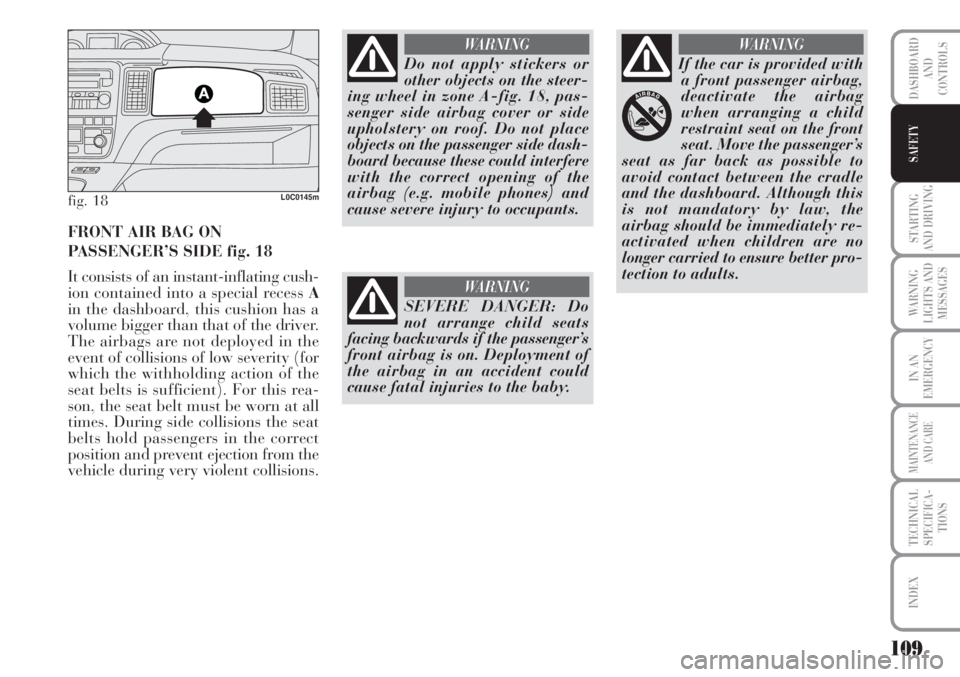
109
STARTING
AND DRIVING
WARNING
LIGHTS AND
MESSAGES
IN AN
EMERGENCY
MAINTENANCE
AND CARE
TECHNICAL
SPECIFICA-
TIONS
INDEX
DASHBOARD
AND
CONTROLS
SAFETY
fig. 18L0C0145m
FRONT AIR BAG ON
PASSENGER’S SIDE fig. 18
It consists of an instant-inflating cush-
ion contained into a special recess A
in the dashboard, this cushion has a
volume bigger than that of the driver.
The airbags are not deployed in the
event of collisions of low severity (for
which the withholding action of the
seat belts is sufficient). For this rea-
son, the seat belt must be worn at all
times. During side collisions the seat
belts hold passengers in the correct
position and prevent ejection from the
vehicle during very violent collisions.
Do not apply stickers or
other objects on the steer-
ing wheel in zone A-fig. 18, pas-
senger side airbag cover or side
upholstery on roof. Do not place
objects on the passenger side dash-
board because these could interfere
with the correct opening of the
airbag (e.g. mobile phones) and
cause severe injury to occupants.
WARNING
SEVERE DANGER: Do
not arrange child seats
facing backwards if the passenger’s
front airbag is on. Deployment of
the airbag in an accident could
cause fatal injuries to the baby.
WARNING
If the car is provided with
a front passenger airbag,
deactivate the airbag
when arranging a child
restraint seat on the front
seat. Move the passenger’s
seat as far back as possible to
avoid contact between the cradle
and the dashboard. Although this
is not mandatory by law, the
airbag should be immediately re-
activated when children are no
longer carried to ensure better pro-
tection to adults.
WARNING